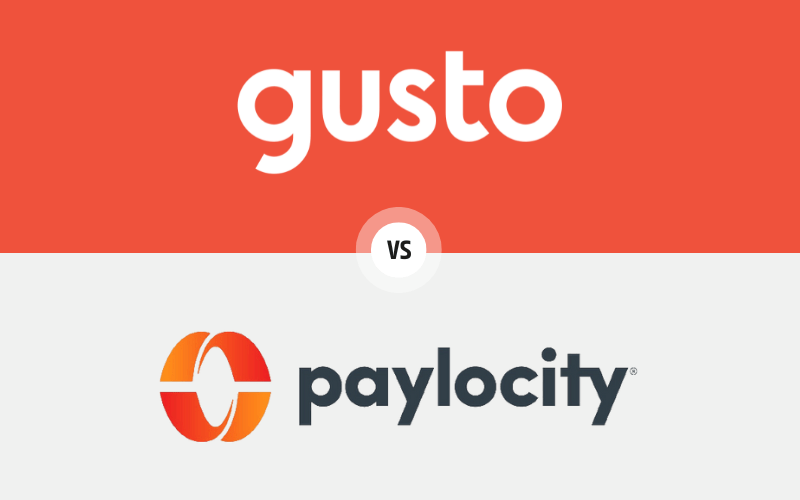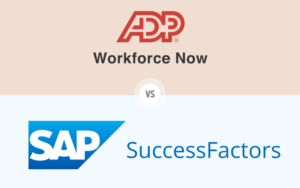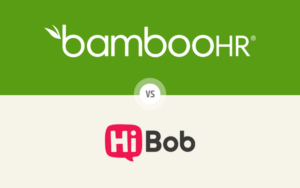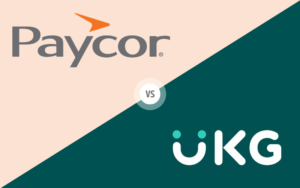When it comes to selecting the best HCM software for your business, comparing Gusto vs Paylocity can provide valuable insights into which platform might be the best fit for your needs. Both Gusto and Paylocity offer comprehensive human capital management solutions, but they cater to different types of organizations and priorities. In this blog post, we’ll dive deep into various aspects of these platforms, including user interface and user experience, core HR functions, payroll management, and more, to help you make an informed decision. Whether you’re a small business seeking simplicity or a larger organization needing advanced features, understanding the strengths and differences of Gusto and Paylocity will guide you toward the right choice for your HR needs.
Table of Contents
User Interface and User Experience
When comparing Gusto vs Paylocity, the user interface (UI) and user experience (UX) are crucial factors to consider. Both platforms are designed to streamline HR processes, but they have distinct approaches to UI and UX. A well-designed interface can significantly enhance productivity, reduce errors, and improve overall user satisfaction. Therefore, understanding the nuances of each platform’s UI and UX can help you make an informed decision that aligns with your organization’s needs.

Gusto User Interface and User Experience
Gusto boasts an intuitive and clean design that prioritizes user-friendliness. Its interface is modern and minimalist, making it easy for users to navigate through various features without extensive training. The layout is structured to reduce clutter, allowing HR teams to efficiently access the tools they need.
Key Features of Gusto UI/UX:
- Customization: Users can personalize the dashboard with widgets and shortcuts to frequently used functions, enhancing efficiency.
- Visual Design: The interface uses clean lines and clear labeling, creating a straightforward and engaging experience for users.
- Ease of Use: The platform is designed to be intuitive, reducing the learning curve for new users and minimizing the need for extensive training.
Paylocity User Interface and User Experience
Paylocity, while also user-friendly, adopts a more feature-rich approach compared to Gusto. Its interface is designed to be comprehensive and functional, catering to the needs of larger organizations with complex HR requirements. The platform offers robust functionality but may require more time to master due to its extensive feature set.
Key Features of Paylocity UI/UX:
- Functionality: The platform provides a wealth of features and options, making it suitable for detailed HR management tasks.
- Navigation: While comprehensive, the interface is logically organized, helping users find the necessary tools and information.
- Professional Design: The design is professional and straightforward, focusing on functionality over aesthetics.
Comparison and Conclusion
In the debate of Gusto vs Paylocity, the choice of user interface and user experience will largely depend on the specific needs of your organization. Gusto excels in providing a modern, visually appealing, and highly intuitive experience, making it ideal for smaller to mid-sized businesses looking for simplicity and ease of use. On the other hand, Paylocity offers a more traditional, feature-rich interface that, while potentially more complex, is suited for larger organizations requiring comprehensive HR functionality.
Choosing between Gusto and Paylocity will depend on whether your priority is a modern, user-friendly design or a comprehensive, functionality-driven interface.
Core HR Functions
When comparing Gusto vs Paylocity, understanding how each platform handles core HR functions is essential. Core HR functions include employee data management, onboarding, offboarding, and compliance, among others. These features are the backbone of any HR software and play a crucial role in maintaining organizational efficiency and regulatory compliance.

Gusto Core HR Functions
Gusto provides a comprehensive suite of core HR functions designed to simplify HR management for small to mid-sized businesses. The platform focuses on ease of use and automation to streamline HR tasks.
Key Features of Gusto Core HR Functions:
- Employee Data Management: Gusto offers a centralized database for storing and managing employee information, making it easy to access and update records.
- Onboarding and Offboarding: The platform provides a seamless onboarding experience with customizable checklists, electronic document signing, and automated workflows. Offboarding is equally efficient, ensuring all necessary steps are followed.
- Compliance: Gusto helps businesses stay compliant with labor laws and regulations by automating tax filings, providing compliance alerts, and offering resources to ensure adherence to legal requirements.
- Document Management: Users can upload, store, and manage important documents securely within the platform, reducing the need for physical paperwork.
Paylocity Core HR Functions
Paylocity is designed to cater to larger organizations with more complex HR needs. Its core HR functions are robust and comprehensive, offering advanced features to support detailed HR management.
Key Features of Paylocity Core HR Functions:
- Employee Data Management: Paylocity provides a detailed and customizable database for employee information, allowing for complex data tracking and reporting.
- Onboarding and Offboarding: The platform offers a thorough onboarding process with customizable workflows, electronic document signing, and training modules. The offboarding process is similarly detailed, ensuring compliance and smooth transitions.
- Compliance: Paylocity includes advanced compliance tools, such as automated federal and state tax filing, ACA compliance tracking, and alerts for regulatory changes.
- Document Management: Paylocity’s document management system allows for secure storage and easy retrieval of important documents, with advanced search capabilities to enhance efficiency.
Comparison and Conclusion
In the comparison of Gusto vs Paylocity for core HR functions, both platforms offer robust solutions but cater to different organizational needs. Gusto excels in providing a user-friendly, automated approach that is ideal for small to mid-sized businesses looking for simplicity and efficiency. Paylocity, on the other hand, offers a more detailed and customizable set of features that are better suited for larger organizations with complex HR requirements.
Choosing between Gusto and Paylocity will depend on the size and specific needs of your organization. If you value ease of use and automation, Gusto is a strong contender. If your organization requires comprehensive and customizable HR solutions, Paylocity may be the better choice.
Payroll Management
Payroll management is a critical component of any HR system, ensuring employees are paid accurately and on time. When comparing Gusto vs Paylocity, it’s essential to examine how each platform handles payroll processing, tax management, and other payroll-related functions.

Gusto Payroll Management
Gusto is well-regarded for its user-friendly payroll management system, designed to simplify payroll processing for small to mid-sized businesses. The platform focuses on automation and ease of use, ensuring a smooth payroll experience.
Key Features of Gusto Payroll Management:
- Automated Payroll Processing: Gusto automates payroll calculations, tax filings, and direct deposits, reducing manual effort and the risk of errors.
- Tax Compliance: The platform automatically calculates, files, and pays federal, state, and local payroll taxes. Gusto also provides W-2s and 1099s at year-end.
- Direct Deposit and Check Options: Employees can choose between direct deposit and printed checks, offering flexibility in how they receive their pay.
- Benefits Integration: Gusto seamlessly integrates payroll with benefits administration, ensuring deductions and contributions are accurately reflected in payroll.
- Employee Self-Service: Employees can access their pay stubs, tax forms, and update their personal information through the self-service portal.
Paylocity Payroll Management
Paylocity offers a robust payroll management system designed to cater to larger organizations with more complex payroll needs. The platform provides comprehensive payroll features that support detailed payroll processing and compliance.
Key Features of Paylocity Payroll Management:
- Comprehensive Payroll Processing: Paylocity offers advanced payroll processing capabilities, including multiple pay rates, shift differentials, and complex pay structures.
- Tax Management: The platform provides automated tax filing and compliance support for federal, state, and local taxes. Paylocity also handles year-end tax reporting and distribution of W-2s and 1099s.
- Flexible Payment Options: Paylocity supports direct deposit, checks, and pay cards, offering various options for employee payment.
- Integration with HR and Benefits: Paylocity integrates payroll with other HR functions and benefits administration, ensuring accurate deductions and contributions.
- Employee Self-Service: Employees can access pay information, tax forms, and make updates through a comprehensive self-service portal.
Comparison and Conclusion
In the comparison of Gusto vs Paylocity for payroll management, both platforms offer robust solutions but are tailored to different organizational needs. Gusto excels in providing an automated, user-friendly payroll system ideal for small to mid-sized businesses. Its seamless integration with tax compliance and benefits administration makes it a convenient choice for companies looking for simplicity and efficiency.
On the other hand, Paylocity offers a more comprehensive payroll management system suited for larger organizations with complex payroll requirements. Its advanced features and flexibility make it a powerful tool for detailed payroll processing and compliance.
Choosing between Gusto and Paylocity will depend on the size and complexity of your payroll needs. If you prioritize ease of use and automation, Gusto is an excellent option. If your organization requires advanced payroll features and greater flexibility, Paylocity may be the better choice.
Time and Attendance Tracking
Effective time and attendance tracking is essential for managing workforce productivity and ensuring accurate payroll. When comparing Gusto vs Paylocity, it’s important to evaluate how each platform handles these functions to support your business needs.

Gusto Time and Attendance Tracking
Gusto offers a straightforward time and attendance tracking system designed for small to mid-sized businesses. The platform focuses on ease of use and integration with payroll, making it simple for employees and managers to track and manage work hours.
Key Features of Gusto Time and Attendance Tracking:
- Simple Clock-In/Clock-Out: Employees can easily clock in and out using Gusto’s web or mobile app, ensuring accurate time tracking.
- Integration with Payroll: Time and attendance data automatically syncs with payroll, reducing manual data entry and ensuring employees are paid accurately for their hours worked.
- Overtime Calculation: Gusto automatically calculates overtime based on your organization’s policies, ensuring compliance with labor laws.
- Time Off Management: Employees can request time off through the platform, and managers can approve or deny requests, with all data integrated into the payroll system.
- Reporting: Gusto provides detailed reports on employee hours, overtime, and time-off balances, helping managers make informed decisions.
Paylocity Time and Attendance Tracking
Paylocity offers a more advanced time and attendance tracking system suitable for larger organizations with complex needs. The platform provides comprehensive features to manage diverse work schedules, track employee time accurately, and ensure compliance.
Key Features of Paylocity Time and Attendance Tracking:
- Advanced Time Tracking: Paylocity supports various time-tracking methods, including web, mobile app, biometric clocks, and physical time clocks, catering to different workplace environments.
- Flexible Scheduling: Managers can create and manage complex schedules, including shifts, breaks, and overtime rules, to meet organizational needs.
- Real-Time Monitoring: Paylocity provides real-time visibility into employee attendance, enabling managers to monitor and address attendance issues promptly.
- Integration with Payroll: Time and attendance data seamlessly integrates with payroll, ensuring accurate and timely payment.
- Compliance Features: The platform helps ensure compliance with labor laws by automatically calculating overtime, managing breaks, and generating audit trails.
- Reporting and Analytics: Paylocity offers advanced reporting and analytics tools to track attendance trends, monitor productivity, and make data-driven decisions.
Comparison and Conclusion
In the comparison of Gusto vs Paylocity for time and attendance tracking, both platforms offer effective solutions but cater to different business sizes and complexities. Gusto provides a simple, user-friendly system ideal for small to mid-sized businesses looking for ease of use and integration with payroll. Its straightforward features make it easy for employees to track their time and for managers to manage attendance.
Paylocity, on the other hand, offers a more advanced system designed for larger organizations with complex scheduling and compliance needs. Its comprehensive features, real-time monitoring, and robust reporting capabilities make it well-suited for businesses requiring detailed time and attendance management.
Choosing between Gusto and Paylocity will depend on your organization’s size and specific needs. If simplicity and ease of use are your priorities, Gusto is an excellent choice. For more complex time and attendance tracking requirements, Paylocity’s advanced features may be the better option.
Benefits Administration
Benefits administration is a crucial aspect of HR management, impacting employee satisfaction and retention. When comparing Gusto vs Paylocity, it’s important to assess how each platform handles benefits administration to ensure it meets your organization’s needs.

Gusto Benefits Administration
Gusto offers a user-friendly benefits administration system designed to simplify the management of employee benefits for small to mid-sized businesses. The platform focuses on ease of use and integration with payroll, making it straightforward for HR teams and employees to manage benefits.
Key Features of Gusto Benefits Administration:
- Comprehensive Benefits Management: Gusto allows businesses to manage a wide range of benefits, including health insurance, dental, vision, life insurance, and retirement plans.
- Integrated Payroll Deductions: Benefit deductions are automatically calculated and integrated with payroll, ensuring accurate and timely processing.
- Employee Self-Service: Employees can enroll in benefits, make changes, and view their benefits information through a self-service portal, reducing the administrative burden on HR teams.
- Benefits Compliance: Gusto helps ensure compliance with federal and state regulations, providing tools and resources to manage ACA reporting and other compliance requirements.
- Benefits Advisory Services: Gusto offers access to licensed benefits advisors who can assist businesses in selecting and managing benefit plans.
Paylocity Benefits Administration
Paylocity provides a robust benefits administration system tailored for larger organizations with complex benefits needs. The platform offers extensive features to support detailed benefits management and ensure compliance.
Key Features of Paylocity Benefits Administration:
- Extensive Benefits Options: Paylocity supports a wide range of benefits, including health insurance, dental, vision, life insurance, disability, retirement plans, and more.
- Automated Enrollment and Management: The platform automates benefits enrollment and management, streamlining the process for both HR teams and employees.
- Compliance Tools: Paylocity provides advanced tools to manage compliance with federal and state regulations, including ACA reporting and COBRA administration.
- Employee Self-Service Portal: Employees can enroll in benefits, update their information, and view their benefits details through a comprehensive self-service portal.
- Analytics and Reporting: Paylocity offers advanced analytics and reporting features to track benefits utilization, costs, and trends, helping HR teams make data-driven decisions.
Comparison and Conclusion
In the comparison of Gusto vs Paylocity for benefits administration, both platforms offer effective solutions but are designed for different organizational needs. Gusto excels in providing a user-friendly, integrated system ideal for small to mid-sized businesses. Its focus on ease of use and seamless integration with payroll makes it a convenient choice for managing employee benefits.
On the other hand, Paylocity offers a more comprehensive benefits administration system suited for larger organizations with complex benefits needs. Its advanced features, compliance tools, and robust reporting capabilities make it well-suited for businesses requiring detailed benefits management.
Choosing between Gusto and Paylocity will depend on the size and specific needs of your organization. If you prioritize simplicity and ease of use, Gusto is an excellent option. For more complex benefits administration requirements, Paylocity’s extensive features may be the better choice.
Performance Management
Performance management is a key element in maintaining a motivated and productive workforce. When comparing Gusto vs Paylocity, it’s important to evaluate how each platform supports performance management processes, including goal setting, feedback, and performance reviews.

Gusto Performance Management
Gusto offers a straightforward performance management system designed for small to mid-sized businesses. The platform emphasizes ease of use and integration with other HR functions to streamline performance management tasks.
Key Features of Gusto Performance Management:
- Goal Setting and Tracking: Gusto allows managers and employees to set and track performance goals, ensuring alignment with company objectives.
- Performance Reviews: The platform supports structured performance review processes, enabling managers to conduct regular evaluations and provide constructive feedback.
- Continuous Feedback: Gusto encourages ongoing feedback between managers and employees, fostering a culture of continuous improvement and development.
- Integration with HR Functions: Performance management features are integrated with other HR functions, such as payroll and benefits, providing a holistic view of employee performance and compensation.
- User-Friendly Interface: The intuitive interface makes it easy for managers and employees to navigate and utilize performance management tools without extensive training.
Paylocity Performance Management
Paylocity provides a comprehensive performance management system suitable for larger organizations with more complex needs. The platform offers advanced features to support detailed performance management and employee development.
Key Features of Paylocity Performance Management:
- Goal Management: Paylocity allows for the creation and tracking of individual and team goals, ensuring alignment with strategic business objectives.
- Structured Performance Reviews: The platform supports various types of performance reviews, including annual, quarterly, and project-based evaluations, with customizable templates and workflows.
- 360-Degree Feedback: Paylocity offers 360-degree feedback, enabling input from peers, subordinates, and supervisors, providing a well-rounded view of employee performance.
- Development Plans: The system includes tools for creating and managing employee development plans, helping to identify and address skill gaps.
- Advanced Analytics: Paylocity provides robust reporting and analytics features, allowing managers to track performance trends and make data-driven decisions.
Comparison and Conclusion
In the comparison of Gusto vs Paylocity for performance management, both platforms offer effective solutions but cater to different organizational needs. Gusto excels in providing a user-friendly, integrated performance management system ideal for small to mid-sized businesses. Its focus on ease of use and continuous feedback makes it a convenient choice for fostering employee development and alignment with company goals.
Paylocity, on the other hand, offers a more comprehensive performance management system suited for larger organizations with complex performance management requirements. Its advanced features, such as 360-degree feedback and detailed analytics, make it well-suited for businesses seeking a thorough and structured approach to performance management.
Choosing between Gusto and Paylocity will depend on the size and specific needs of your organization. If you value simplicity and integration with other HR functions, Gusto is an excellent option. For more advanced performance management features and detailed employee development tools, Paylocity may be the better choice.
Talent Management and Recruiting
Effective talent management and recruiting are crucial for attracting, retaining, and developing top talent within an organization. When comparing Gusto vs Paylocity, it’s important to assess how each platform supports these functions to meet your business needs.

Gusto Talent Management and Recruiting
Gusto offers basic talent management and recruiting features that are well-suited for small to mid-sized businesses. The platform focuses on simplifying the hiring process and ensuring a smooth transition from candidate to employee.
Key Features of Gusto Talent Management and Recruiting:
- Job Posting and Applicant Tracking: Gusto allows businesses to post job openings and manage applicants through an integrated tracking system, making it easy to review and communicate with candidates.
- Onboarding: Once a candidate is hired, Gusto provides a seamless onboarding experience with customizable checklists, electronic document signing, and automated workflows to ensure a smooth transition.
- Employee Development: Gusto includes basic tools for tracking employee development and performance, helping managers identify growth opportunities and support career progression.
- Integration with Core HR Functions: Talent management and recruiting features are integrated with other HR functions, providing a holistic view of the employee lifecycle.
Paylocity Talent Management and Recruiting
Paylocity offers a more advanced talent management and recruiting system designed for larger organizations with complex needs. The platform provides comprehensive features to support the entire talent lifecycle, from hiring to development and retention.
Key Features of Paylocity Talent Management and Recruiting:
- Advanced Applicant Tracking System (ATS): Paylocity’s ATS supports a detailed and customizable hiring process, including job postings, candidate screening, interview scheduling, and communication.
- Onboarding and Engagement: Paylocity provides a thorough onboarding process with customizable workflows, training modules, and engagement tools to ensure new hires are integrated smoothly and effectively.
- Talent Development: The platform includes robust tools for managing employee development, such as goal setting, performance reviews, and learning management systems (LMS) to support continuous growth.
- Succession Planning: Paylocity offers tools for succession planning, helping organizations identify and prepare future leaders by tracking potential and readiness.
- Analytics and Reporting: Paylocity provides advanced analytics and reporting capabilities to track recruitment metrics, employee performance, and development trends, aiding in data-driven decision-making.
Comparison and Conclusion
In the comparison of Gusto vs Paylocity for talent management and recruiting, both platforms offer effective solutions but cater to different organizational needs. Gusto excels in providing a straightforward, integrated system ideal for small to mid-sized businesses. Its focus on simplifying the hiring and onboarding process makes it a convenient choice for organizations looking to streamline their talent acquisition efforts.
On the other hand, Paylocity offers a more comprehensive talent management and recruiting system suited for larger organizations with complex requirements. Its advanced features, such as a robust applicant tracking system, detailed onboarding, and extensive employee development tools, make it well-suited for businesses seeking a thorough and structured approach to managing talent.
Choosing between Gusto and Paylocity will depend on the size and specific needs of your organization. If you value simplicity and ease of use, Gusto is an excellent option. For more advanced talent management and recruiting features, Paylocity may be the better choice.
Learning and Development
Learning and development (L&D) are vital for employee growth and organizational success. When comparing Gusto vs Paylocity, it’s important to evaluate how each platform supports L&D initiatives to enhance employee skills and career progression.

Gusto Learning and Development
Gusto offers basic learning and development features suitable for small to mid-sized businesses. The platform integrates L&D with other HR functions, providing a cohesive experience for managing employee growth.
Key Features of Gusto Learning and Development:
- Onboarding Training: Gusto facilitates onboarding with training modules that help new hires understand company policies, procedures, and culture.
- Performance Feedback: The platform includes tools for continuous feedback and performance reviews, helping managers identify areas for development and provide targeted training.
- Resource Library: Gusto offers a resource library where employees can access training materials, company policies, and other important documents.
- Integration with HR Functions: Learning and development features are integrated with payroll and performance management, offering a unified view of employee progress and training needs.
Paylocity Learning and Development
Paylocity provides a comprehensive learning and development system designed for larger organizations with extensive L&D needs. The platform offers advanced tools to support continuous learning and employee development.
Key Features of Paylocity Learning and Development:
- Learning Management System (LMS): Paylocity includes a robust LMS that allows businesses to create, manage, and track training programs and courses. Employees can access training materials, complete courses, and track their progress.
- Customized Training Programs: The platform supports the creation of customized training programs tailored to specific roles, departments, or skill sets, ensuring relevant and targeted learning.
- Employee Development Plans: Paylocity enables managers to create and track development plans, helping employees set career goals and identify the necessary steps to achieve them.
- Compliance Training: The system provides tools for managing compliance training, ensuring employees complete mandatory courses and stay up-to-date with regulatory requirements.
- Advanced Reporting and Analytics: Paylocity offers detailed reporting and analytics to track training effectiveness, employee progress, and skill gaps, aiding in data-driven L&D decisions.
Comparison and Conclusion
In the comparison of Gusto vs Paylocity for learning and development, both platforms offer solutions but are tailored to different organizational needs. Gusto excels in providing a user-friendly, integrated L&D system ideal for small to mid-sized businesses. Its focus on onboarding and performance feedback makes it a convenient choice for organizations looking to support basic employee development.
Paylocity, on the other hand, offers a more advanced learning and development system suited for larger organizations with comprehensive L&D requirements. Its robust LMS, customized training programs, and detailed reporting capabilities make it well-suited for businesses seeking to foster continuous learning and development.
Choosing between Gusto and Paylocity will depend on the size and specific needs of your organization. If you prioritize ease of use and integration with other HR functions, Gusto is an excellent option. For more advanced learning and development features, Paylocity may be the better choice.
Reporting and Analytics
Effective reporting and analytics are essential for making informed HR decisions and improving organizational performance. When comparing Gusto vs Paylocity, it’s important to evaluate how each platform handles reporting and analytics to provide actionable insights.

Gusto Reporting and Analytics
Gusto offers basic reporting and analytics features that cater to small to mid-sized businesses. The platform focuses on simplicity and ease of use, providing essential reports that help businesses stay informed and compliant.
Key Features of Gusto Reporting and Analytics:
- Standard Reports: Gusto provides a variety of standard reports covering payroll, benefits, time tracking, and compliance, giving businesses a clear view of essential HR metrics.
- Customizable Reports: Users can customize reports to focus on specific data points and metrics relevant to their organization’s needs.
- Compliance Reporting: Gusto includes tools for generating compliance reports, ensuring businesses can meet regulatory requirements and avoid penalties.
- User-Friendly Interface: The reporting interface is intuitive, making it easy for users to generate and interpret reports without extensive training.
- Integration with HR Functions: Gusto’s reporting features are integrated with payroll, benefits, and other HR functions, providing a holistic view of employee data.
Paylocity Reporting and Analytics
Paylocity offers a more advanced reporting and analytics system designed for larger organizations with complex data needs. The platform provides comprehensive tools to support detailed analysis and strategic decision-making.
Key Features of Paylocity Reporting and Analytics:
- Advanced Reporting: Paylocity provides a wide range of advanced reports covering all aspects of HR, including payroll, benefits, performance, and compliance.
- Custom Report Builder: The platform includes a custom report builder that allows users to create detailed and specific reports tailored to their unique needs.
- Real-Time Analytics: Paylocity offers real-time analytics, enabling businesses to access up-to-date data and make timely decisions.
- Dashboards and Visualizations: The platform provides interactive dashboards and data visualizations, helping users to quickly identify trends and insights.
- Compliance and Audit Reporting: Paylocity includes robust compliance and audit reporting tools, ensuring businesses can easily meet regulatory requirements and conduct internal audits.
- Integration with Other Systems: Paylocity’s reporting features integrate seamlessly with other HR functions and external systems, providing a comprehensive view of organizational data.
Comparison and Conclusion
In the comparison of Gusto vs Paylocity for reporting and analytics, both platforms offer valuable solutions but are designed for different organizational needs. Gusto excels in providing a user-friendly, integrated reporting system ideal for small to mid-sized businesses. Its focus on essential reports and ease of use makes it a convenient choice for organizations looking to stay informed and compliant.
Paylocity, on the other hand, offers a more advanced reporting and analytics system suited for larger organizations with complex data requirements. Its comprehensive tools, real-time analytics, and customizable reports make it well-suited for businesses seeking to gain deeper insights and make data-driven decisions.
Choosing between Gusto and Paylocity will depend on the size and specific needs of your organization. If you value simplicity and ease of use, Gusto is an excellent option. For more advanced reporting and analytics features, Paylocity may be the better choice.
Compliance and Security
Compliance and security are critical aspects of any HR software, ensuring that sensitive employee data is protected and that the organization adheres to regulatory requirements. When comparing Gusto vs Paylocity, it’s essential to examine how each platform addresses these important concerns.

Gusto Compliance and Security
Gusto prioritizes compliance and security, providing robust features to help small to mid-sized businesses manage regulatory requirements and protect sensitive information.
Key Features of Gusto Compliance and Security:
- Automated Tax Filings: Gusto automatically calculates, files, and pays federal, state, and local payroll taxes, reducing the risk of errors and ensuring timely compliance.
- Compliance Alerts: The platform provides alerts for compliance deadlines and regulatory changes, helping businesses stay up-to-date with labor laws and tax regulations.
- Employee Classification: Gusto assists in correctly classifying employees and contractors, which is crucial for compliance with wage and hour laws.
- Data Encryption: Gusto uses industry-standard encryption to protect sensitive data during transmission and storage, ensuring that employee information is secure.
- Regular Security Audits: The platform undergoes regular security audits to identify and mitigate potential vulnerabilities, maintaining a high standard of security.
Paylocity Compliance and Security
Paylocity offers comprehensive compliance and security features designed for larger organizations with complex needs. The platform provides advanced tools to ensure regulatory compliance and protect employee data.
Key Features of Paylocity Compliance and Security:
- Comprehensive Tax Compliance: Paylocity automates federal, state, and local tax filings, including year-end reporting and W-2/1099 distribution, ensuring accurate and timely compliance.
- ACA Compliance: The platform includes tools to manage Affordable Care Act (ACA) compliance, including eligibility tracking and reporting.
- Data Security Measures: Paylocity employs advanced security measures, such as multi-factor authentication, data encryption, and regular security audits, to protect sensitive information.
- Role-Based Access Control: The system provides role-based access control, ensuring that employees can only access data relevant to their role, enhancing data security.
- Compliance Reporting: Paylocity offers robust compliance reporting tools, helping organizations generate necessary reports for various regulatory requirements and internal audits.
Comparison and Conclusion
In the comparison of Gusto vs Paylocity for compliance and security, both platforms offer strong solutions but cater to different organizational needs. Gusto excels in providing a user-friendly compliance and security system ideal for small to mid-sized businesses. Its automated tax filings, compliance alerts, and strong data encryption make it a reliable choice for managing compliance and protecting sensitive information.
Paylocity, on the other hand, offers a more comprehensive compliance and security system suited for larger organizations with complex requirements. Its advanced tools, such as ACA compliance management, role-based access control, and extensive security measures, make it well-suited for businesses needing detailed compliance and robust data protection.
Choosing between Gusto and Paylocity will depend on the size and specific needs of your organization. If you value simplicity and ease of use, Gusto is an excellent option. For more advanced compliance and security features, Paylocity may be the better choice.
Integration and Compatibility
Integration and compatibility are essential factors to consider when selecting HR software, ensuring that the platform can seamlessly connect with other systems and tools your organization uses. When comparing Gusto vs Paylocity, it’s important to assess how each platform handles integrations and their compatibility with various third-party applications.

Gusto Integration and Compatibility
Gusto offers a range of integrations designed to meet the needs of small to mid-sized businesses. The platform focuses on providing easy-to-use connections with popular business tools, ensuring a smooth and efficient workflow.
Key Features of Gusto Integration and Compatibility:
- Accounting Software Integration: Gusto integrates with popular accounting software such as QuickBooks, Xero, and FreshBooks, streamlining payroll and financial management.
- Time Tracking Tools: The platform connects with time tracking tools like TSheets and Homebase, ensuring accurate timekeeping and payroll processing.
- Benefits Providers: Gusto integrates with a variety of benefits providers, making it easy to manage health insurance, retirement plans, and other employee benefits.
- API Access: Gusto provides API access for custom integrations, allowing businesses to connect the platform with other software tools and systems they use.
- HR and Productivity Tools: The platform integrates with HR and productivity tools such as Slack, Asana, and Google Workspace, enhancing collaboration and efficiency.
Paylocity Integration and Compatibility
Paylocity offers a comprehensive integration ecosystem designed for larger organizations with complex needs. The platform provides robust integration capabilities to ensure seamless connectivity with a wide range of third-party applications and systems.
Key Features of Paylocity Integration and Compatibility:
- HRIS Integration: Paylocity integrates with various HR information systems (HRIS), ensuring that employee data is synchronized across platforms for accurate and efficient HR management.
- Accounting and ERP Systems: The platform connects with leading accounting and enterprise resource planning (ERP) systems, facilitating smooth financial and operational workflows.
- Time and Attendance Systems: Paylocity supports integration with a variety of time and attendance systems, ensuring accurate time tracking and payroll processing.
- Benefits Administration: The platform integrates with numerous benefits providers and brokers, simplifying the management of employee benefits and compliance.
- API and Custom Integrations: Paylocity offers extensive API capabilities, allowing organizations to create custom integrations with other software tools and systems, tailored to their specific needs.
- Single Sign-On (SSO): The platform supports single sign-on (SSO) for enhanced security and streamlined user access to multiple applications.
Comparison and Conclusion
In the comparison of Gusto vs Paylocity for integration and compatibility, both platforms offer robust solutions but cater to different organizational needs. Gusto excels in providing a user-friendly integration system ideal for small to mid-sized businesses. Its focus on connecting with popular accounting, time tracking, and productivity tools makes it a convenient choice for organizations looking for straightforward integrations.
Paylocity, on the other hand, offers a more comprehensive integration ecosystem suited for larger organizations with complex requirements. Its extensive API capabilities, support for HRIS and ERP systems, and robust benefits administration integrations make it well-suited for businesses needing detailed and customizable integration options.
Choosing between Gusto and Paylocity will depend on the size and specific needs of your organization. If you value simplicity and ease of use, Gusto is an excellent option. For more advanced integration and compatibility features, Paylocity may be the better choice.
Customer Support and Service
Customer support and service are critical factors when selecting HR software, as they ensure that users can get help when they need it and make the most out of the platform’s features. When comparing Gusto vs Paylocity, it’s important to evaluate the quality and availability of customer support and service offered by each platform.

Gusto Customer Support and Service
Gusto is known for its responsive and user-friendly customer support, which is designed to assist small to mid-sized businesses in effectively using the platform.
Key Features of Gusto Customer Support and Service:
- Multiple Support Channels: Gusto offers support through various channels, including phone, email, and live chat, ensuring users can get help in the way that suits them best.
- Help Center and Resources: The platform provides a comprehensive help center with articles, tutorials, and FAQs that cover a wide range of topics, helping users find answers quickly.
- Dedicated Account Managers: For businesses with more complex needs, Gusto offers dedicated account managers who provide personalized support and guidance.
- Onboarding Assistance: Gusto provides onboarding support to help new users set up their accounts, understand the features, and start using the platform efficiently.
- Community Forum: Users can access a community forum where they can ask questions, share experiences, and get advice from other Gusto users.
Paylocity Customer Support and Service
Paylocity offers robust customer support and service designed to meet the needs of larger organizations with more complex HR requirements. The platform focuses on providing comprehensive assistance through various channels.
Key Features of Paylocity Customer Support and Service:
- 24/7 Support: Paylocity offers 24/7 customer support through phone and email, ensuring that users can get help whenever they need it.
- Extensive Knowledge Base: The platform provides an extensive knowledge base with articles, video tutorials, and guides that cover a wide range of topics and issues.
- Dedicated Account Managers: Paylocity assigns dedicated account managers to clients, offering personalized support and ensuring that users get the most out of the platform.
- Implementation Support: Paylocity offers thorough implementation support, including data migration and system setup, to help new clients transition smoothly.
- Training Programs: The platform provides various training programs and webinars to help users understand the features and functionalities of Paylocity.
- Community and Networking: Paylocity hosts user groups and networking events where clients can connect, share best practices, and learn from each other.
Comparison and Conclusion
In the comparison of Gusto vs Paylocity for customer support and service, both platforms offer robust solutions but are tailored to different organizational needs. Gusto excels in providing responsive and user-friendly support ideal for small to mid-sized businesses. Its multiple support channels, dedicated account managers, and comprehensive help center make it a convenient choice for users looking for accessible and effective assistance.
Paylocity, on the other hand, offers a more comprehensive support system suited for larger organizations with complex requirements. Its 24/7 support, extensive knowledge base, dedicated account managers, and thorough implementation support make it well-suited for businesses needing detailed and continuous assistance.
Choosing between Gusto and Paylocity will depend on the size and specific needs of your organization. If you value simplicity and responsive support, Gusto is an excellent option. For more advanced and continuous support services, Paylocity may be the better choice.
Pricing and Cost-effectiveness
Pricing and cost-effectiveness are critical considerations when selecting HR software, as they directly impact your organization’s budget and return on investment. When comparing Gusto vs Paylocity, it’s important to evaluate the pricing structures and determine which platform offers the best value for your needs.

Gusto Pricing and Cost-effectiveness
Gusto is known for its transparent and straightforward pricing model, making it a popular choice for small to mid-sized businesses. The platform offers several pricing tiers to accommodate different business sizes and requirements.
Key Features of Gusto Pricing and Cost-effectiveness:
- Simple Pricing Tiers: Gusto offers three main pricing plans: Core, Complete, and Concierge, each with varying levels of features and services.
- Affordable Monthly Fees: Pricing starts at a base fee plus a per-employee fee, making it scalable and cost-effective for growing businesses.
- All-Inclusive Features: Each plan includes essential features such as payroll processing, employee self-service, and basic compliance tools, ensuring businesses get comprehensive functionality without hidden costs.
- No Hidden Fees: Gusto prides itself on transparency, with no hidden fees or surprise charges, allowing businesses to budget accurately.
- Free Trial: Gusto offers a free trial period, allowing businesses to test the platform and evaluate its suitability before committing financially.
For more information about pricing, please visit Gusto’s website.
Paylocity Pricing and Cost-effectiveness
Paylocity provides a more complex pricing structure designed to cater to larger organizations with extensive needs. While specific pricing details are not publicly available and require a quote, the platform offers a wide range of features and customization options.
Key Features of Paylocity Pricing and Cost-effectiveness:
- Customizable Pricing: Paylocity’s pricing is customizable based on the specific needs and size of the organization, ensuring that businesses pay for the features they require.
- Bundled Services: The platform offers bundled services that can include payroll, HR, benefits administration, and more, providing comprehensive solutions at a competitive price.
- Value for Large Organizations: Paylocity’s advanced features and robust capabilities make it cost-effective for larger organizations that need detailed and customizable solutions.
- Consultation-Based Quotes: Paylocity provides personalized quotes after consultation, ensuring that businesses receive a pricing plan tailored to their unique requirements.
- Potential for Volume Discounts: Larger organizations may benefit from volume discounts, reducing the overall cost per employee for extensive deployments.
For more information about pricing, please visit Paylocity’s website.
Comparison and Conclusion
In the comparison of Gusto vs Paylocity for pricing and cost-effectiveness, both platforms offer valuable solutions but cater to different organizational needs. Gusto excels in providing a transparent, affordable pricing model ideal for small to mid-sized businesses. Its simple pricing tiers, all-inclusive features, and lack of hidden fees make it a cost-effective choice for businesses looking for straightforward and scalable HR solutions.
Paylocity, on the other hand, offers a more complex and customizable pricing structure suited for larger organizations with extensive needs. Its bundled services, personalized quotes, and potential for volume discounts provide cost-effectiveness for businesses requiring comprehensive and customizable solutions.
Choosing between Gusto and Paylocity will depend on the size and specific needs of your organization. If you value transparency and affordability, Gusto is an excellent option. For more tailored and extensive pricing solutions, Paylocity may be the better choice.
User Reviews and Testimonials
User reviews and testimonials are valuable resources for evaluating HR software, providing insights into real-world experiences and satisfaction levels. When comparing Gusto vs Paylocity, examining user feedback can help determine which platform best meets your organization’s needs.

Gusto User Reviews and Testimonials
Gusto is highly regarded for its user-friendly interface and excellent customer support, consistently receiving positive feedback from small to mid-sized businesses.
Key Highlights from Gusto User Reviews and Testimonials:
- Ease of Use: Many users praise Gusto for its intuitive and clean design, which makes it easy to navigate and use without extensive training.
- Customer Support: Gusto’s customer support receives high marks for responsiveness and helpfulness, with users appreciating the multiple support channels available.
- Payroll Processing: Users often highlight the seamless payroll processing and automated tax filing features, which simplify payroll management and ensure compliance.
- Onboarding: The onboarding process is frequently commended for being smooth and efficient, with electronic document signing and customizable checklists.
- Overall Satisfaction: Gusto has a strong reputation for customer satisfaction, with many users expressing high levels of contentment with the platform’s functionality and ease of use.
Example Testimonial: “Gusto has been a game-changer for our small business. The platform is incredibly easy to use, and the customer support team is always there to help when we need it. Payroll and onboarding have never been this simple!” – Sarah M., Small Business Owner
Paylocity User Reviews and Testimonials
Paylocity is well-regarded for its comprehensive features and customization options, often receiving positive feedback from larger organizations with complex needs.
Key Highlights from Paylocity User Reviews and Testimonials:
- Advanced Features: Users appreciate the extensive range of features Paylocity offers, including detailed reporting, robust compliance tools, and advanced performance management.
- Customization: Many reviews highlight Paylocity’s ability to customize solutions to fit specific organizational needs, which is particularly beneficial for larger businesses.
- Customer Support: Paylocity’s customer support is praised for its 24/7 availability and the dedicated account managers who provide personalized assistance.
- Integration: Users value the platform’s ability to integrate seamlessly with other systems and tools, enhancing overall workflow efficiency.
- Overall Satisfaction: Paylocity receives strong reviews for its comprehensive capabilities and the positive impact it has on HR management within larger organizations.
Example Testimonial: “Paylocity has transformed the way we manage HR. The platform’s advanced features and customizability have been perfect for our large organization. The support team is always available to assist us, making the transition smooth and effective.” – John D., HR Director
Comparison and Conclusion
In the comparison of Gusto vs Paylocity for user reviews and testimonials, both platforms receive positive feedback but from different types of organizations. Gusto is highly praised by small to mid-sized businesses for its ease of use, excellent customer support, and efficient payroll processing. Users appreciate the straightforward functionality and the platform’s ability to simplify HR tasks.
Paylocity, on the other hand, is lauded by larger organizations for its comprehensive features, customization options, and robust customer support. Users value the advanced capabilities and the platform’s ability to handle complex HR needs efficiently.
Choosing between Gusto and Paylocity will depend on the size and specific needs of your organization. If you prioritize ease of use and exceptional customer support, Gusto is an excellent option. For more advanced features and customization suited to larger organizations, Paylocity may be the better choice.
Conclusion
When comparing Gusto vs Paylocity, it’s clear that both platforms offer robust HR solutions, but they cater to different organizational needs. Your choice between the two will depend on factors such as the size of your business, the complexity of your HR requirements, and your budget.
Gusto is an excellent choice for small to mid-sized businesses that prioritize ease of use, affordability, and seamless integration of essential HR functions. Its intuitive interface, straightforward pricing, and strong customer support make it a reliable and user-friendly option for businesses looking to streamline their HR processes. Gusto excels in areas such as payroll management, benefits administration, and compliance, offering comprehensive features without overwhelming complexity.
Paylocity, on the other hand, is designed to meet the needs of larger organizations with more complex HR requirements. It offers advanced features, extensive customization options, and robust reporting and analytics capabilities. Paylocity is ideal for businesses that require detailed performance management, comprehensive benefits administration, and advanced compliance tools. Its ability to integrate with various systems and provide personalized support through dedicated account managers makes it a powerful solution for organizations with intricate HR needs.
Final Thoughts
Choosing between Gusto and Paylocity ultimately comes down to understanding your organization’s specific needs and priorities. If you value simplicity, ease of use, and cost-effectiveness, Gusto is likely the better fit. For businesses that require advanced features, customization, and robust support, Paylocity offers a more suitable solution.
Both platforms have received positive reviews from users, highlighting their strengths in different areas. By carefully considering the features, pricing, and user feedback for each platform, you can make an informed decision that aligns with your business goals and helps you effectively manage your HR processes.
![]()
![]() Read our full Gusto review
Read our full Gusto review
![]()
![]() Read our full Paylocity review
Read our full Paylocity review




